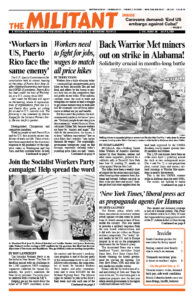Workers face a triple whammy today — continued high unemployment, price hikes on basic necessities like gas and food, and efforts by the bosses to protect their dog-eat-dog competitive edge and profits on our backs. What millions confront shows the need to build and strengthen our unions to lead a struggle to get jobless workers back to work now and for automatic cost-of-living adjustments to defend our pay and benefits.
But these aren’t the problems the well-remunerated pundits in the bosses’ press see. “Ordinary people do not view prices like economists,” wrote Financial Times columnist Gillian Tett, because workers are beset by “anxiety and anger.” The trick for the government, she argues, is to keep “inflation expectations” low so price hikes don’t translate “into higher demands for wages.” Not surprisingly, government bureaucrats jump on that message, repeatedly claiming today’s punishing price hikes are only “transitory.” Today’s “transition” has already lasted at least five months, hitting workers’ incomes.
When she was a governor at the Federal Reserve in 1996, Janet Yellen, now Joe Biden’s treasury secretary, had argued that inflation has some positives because it “allowed firms to cut real wages without upsetting workers.”
Even as spreading vaccination has meant more hiring, average hourly earnings still dropped 2.8% in May from the previous year. Today’s job openings have already meant workers have more confidence to fight for raises and better jobs. “How Do They Say Economic Recovery? ‘I Quit’’’ was the headline in the June 20 New York Times. The paper reports nearly 4 million workers quit their jobs in April looking for better wages and working conditions, with more than 740,000 in hotels, restaurants and other food services.
And there are a number of strikes and lockouts — at Volvo Truck, ExxonMobil’s Texas refinery, ATI steel, Warrior Met coal mine, and more — where workers are fighting against boss demands for more concessions or to get back past givebacks. All these fights deserve support and set an example.
For sliding scale of hours and wages
“The fact that capitalist governments are unwilling and unable to hold down prices doesn’t mean workers must accept the ravages of unbridled inflation,” Dennis Richter, Socialist Workers Party candidate for California governor, told the Militant. “Workers and our unions need to fight for a sliding scale of hours and wages. For a shorter workweek with no cut in pay to spread the jobs around to all who need them,” Richter said, pointing to the fact the government says some 7.6 million more workers are out of work today than before the pandemic. “And for escalator clauses in all union contracts and government benefits so when prices go up the wage of every working person is protected 100%.”
There have been many times where workers fought for and won escalator clauses in labor battles.
In 1970 some 350,000 United Auto Workers members at General Motors struck for 67 days for higher wages, pensions and guaranteed cost-of-living wage increases tied to the rate of inflation — with no ceiling.
Their fight aimed to reverse what had been conceded three years earlier when the auto bosses pressed the union to limit cost-of-living adjustment payments. As prices subsequently soared, fueled by government spending on the U.S. rulers’ war in Vietnam, the reduction in COLA payments saw GM bosses pocket millions and each worker lose an estimated $1,000 over the course of that contract.
The 1970 strike won gains. The new contract restored COLA payments to earlier levels, to be adjusted every three months, with no cap.
Other unionists also went on strike, including postal workers, fighting for cost-of-living adjustment protection in 1970.
Like any other wage raise, COLA increases come out of bosses’ profits. Eliminating them became a key target of employers’ stepped-up offensive against workers and our unions in the decades since.
“In addition to strengthening the labor movement, workers need to fight for forming price committees of our unions, farmers organizations, housewives and other consumers to force open the books of the bosses, and take control over setting prices,” Richter said. “Doing so is the best way to convince farmers and other small businesspeople that it’s the bosses’ profiteering, not workers’ wage demands, that cause inflation.
“I also campaign for workers to get vaccinated. Our unions should organize vaccination programs, explain why it’s in the interests of all workers and urge them to do so. That’s the only way to destroy the virus for good,” he added.


